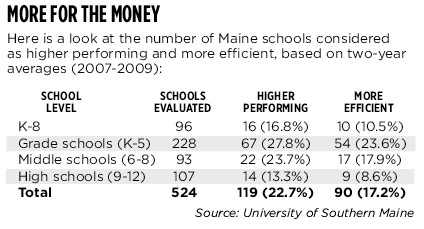PORTLAND – A study from the University of Southern Maine suggests that improving education in cost-effective ways is less a matter of major public policy initiatives than of the culture inside each school.
Researchers at the university set out to discover what distinguished 90 schools where students outperformed their peers at similar schools and where per-pupil spending was lower than the state averages.
They found that one-quarter of Maine’s public schools are exceeding expectations, which Professor David Silvernail said rounds out the picture from a much-discussed report from Harvard University’s Program on Education Policy and Governance.
The Harvard study ranked Maine next-to-last in improving achievement since 1992. Gov. Paul LePage and Education Commissioner Stephen Bowen have cited the study in pushing their education policy agenda.
Schools all around Maine are producing results and can serve as examples for others, said Silvernail, director of the Center for Educational Policy, Applied Research and Evaluation at USM.
“After the Harvard report, people were saying we need to look at other states and other nations,” Silvernail said, “and that’s true. What we’re saying here is we need to look in our own backyard. We have schools that are doing well with a variety of kids.”
The USM report, written by Silvernail and research associate Erika Stump, was released last week after a multiyear study commissioned by the Legislature and funded by the state, USM and the Nellie Mae Education Foundation.
“The education committee asked us to see if we could find more efficient schools, meaning schools that were getting better performance for their spending, and if we could find them, go in and study to see if we could identify why they are more efficient, so other schools could learn from it,” Silvernail said.
Based on standardized test scores and graduation rates for 2007-2009, the researchers identified 119 schools out of 524 that outperformed state averages and similar schools.
Of the higher-performing schools, 90, or about three-quarters, were identified as “more efficient” because they spent less on instructional expenses per pupil than schools in similar communities. Spending on transportation, central office administration, facilities and debt service was not included.
At all levels, the more efficient schools had slightly more students per teacher or education technician. More efficient middle schools and high schools tended to be larger than the state average size, and they also had fewer low-income or special-needs students.
The disparity was especially stark in high schools, where schools on average have 44 percent of students who qualify for free or reduced lunch, while it is only 15 percent at more efficient high schools.
Per-pupil spending at more efficient schools was lower than the state average by 12 percent for kindergarten-through- grade 8 schools, 3 percent for kindergarten through grade 5, 7 percent for middle schools and 1.3 percent for high schools.
To figure out what was behind the numbers, the researchers observed classes and interviewed staff members at 16 more efficient and nine typical schools.
In the more efficient schools, students’ intellectual development was at the center of all work. Students and staff were held to high standards, and educators were motivated by a sense of moral obligation and a belief in equity, according to the study.
“There’s a fundamental belief in those schools that all students can learn, and their job was to ensure that all kids have the appropriate opportunities to reach those expectations,” Silvernail said.
The more efficient schools also used money and time wisely. They were more likely to require that all teachers complete the same professional development, for example, and one school maximized the school day by filling one of two daily recesses with activities to reinforce learning, such as counting steps.
The study’s findings about the importance of student-focused schools and high standards align with common sense and other research, said Lewiston Rep. Richard Wagner, the ranking Democrat on the education committee.
“There’s plenty of high-quality education going on, and I know that Maine students are not looked down upon,” Wagner said. He was alluding to LePage’s statement made in the wake of the Harvard University report that, “I don’t care where you go in this country — if you come from Maine, you’re looked down upon now.”
Department of Education spokesman David Connerty-Marin said state officials are always looking for strategies for success, but findings such as the ones in the USM report won’t necessarily translate into public policy.
“Ultimately, while we can push ideas and practices that we think are effective at the state level, for many, many things the decision-making by law is at the local level,” Connerty-Marin said. “Certainly, the commissioner can use his platform to share some of these ideas.”
Silvernail said his research team is studying improving schools to show how a school can move from typical to more efficient.
He hopes the new study will be valuable for high schools, which were under-represented among more efficient schools. The nine more efficient high schools in the state had fewer low-income and special-needs students than average.
“It may take longer, or they may have had more barriers, but the improving schools are exhibiting many of the characteristics of more-efficient schools,” Silvernail said. “They’re just not as pervasive in the school yet.”
Kennebec Journal Staff Writer Susan McMillan can be reached at 621-5645 or at:
smcmillan@mainetoday.com
Send questions/comments to the editors.


